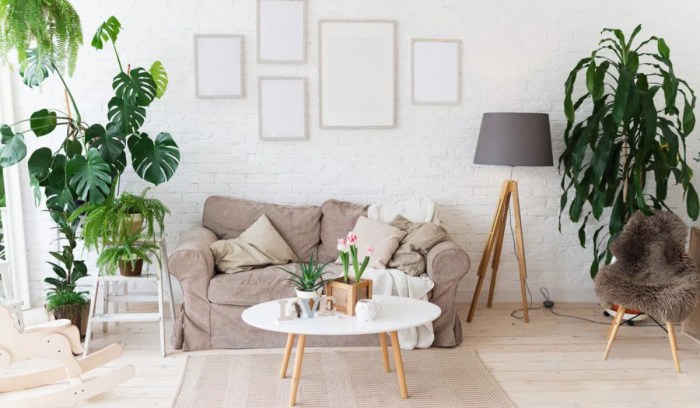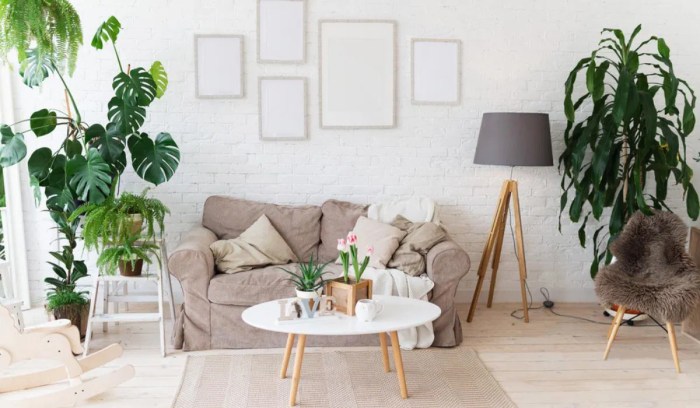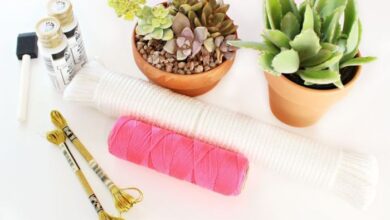
Learning about indoor plants opens a world of possibilities for enriching your home and well-being. Bringing the beauty and serenity of nature indoors is a rewarding experience, but it can seem daunting for beginners. This guide will provide you with the essential knowledge to confidently cultivate a thriving indoor garden, from choosing the right plants to mastering their care.
We’ll explore the diverse benefits of indoor plants, such as improving air quality, reducing stress, and adding a touch of vibrancy to your living spaces. You’ll learn about the basic requirements for indoor plant survival, including light, water, and temperature, and discover a range of popular plants suitable for various light conditions.
We’ll also delve into the art of plant selection, considering your personal preferences and lifestyle to ensure you choose plants that thrive in your home. From repotting and propagation to tackling common pests and diseases, this comprehensive guide will equip you with the tools to nurture your indoor plants and create a thriving oasis within your own four walls.
The Basics of Indoor Plants
Bringing the outdoors in is a fantastic way to improve your home’s atmosphere and well-being. Indoor plants not only add a touch of nature to your living space but also offer a variety of benefits.
Benefits of Indoor Plants, Learning about indoor plants
Indoor plants have been shown to enhance air quality by absorbing pollutants and releasing oxygen. They can also reduce stress, improve focus, and boost creativity. Additionally, they can add color and vibrancy to any room, making it feel more inviting and welcoming.
Essential Requirements for Indoor Plant Survival
Like any living organism, indoor plants require specific conditions to thrive. Understanding these requirements is crucial for keeping your plants healthy and happy.
Light
Light is essential for photosynthesis, the process by which plants convert sunlight into energy. The amount of light your plant needs will depend on its species.
- Low Light: Plants that tolerate low light conditions can survive in areas with minimal direct sunlight, such as a north-facing window or a corner of a room. Examples include Snake Plant, ZZ Plant, and Cast Iron Plant.
- Medium Light: These plants thrive in areas with bright, indirect light, such as a window with eastern or western exposure. Examples include Peace Lily, Spider Plant, and Chinese Evergreen.
- High Light: Plants that need high light require several hours of direct sunlight daily, such as a south-facing window. Examples include Ficus, Monstera, and Bird of Paradise.
Water
Watering is another crucial aspect of indoor plant care. Overwatering is a common problem that can lead to root rot, so it’s essential to let the soil dry out slightly between waterings. The frequency of watering will depend on the plant’s species, the size of the pot, and the environmental conditions.
Temperature
Most indoor plants prefer temperatures between 65°F and 75°F (18°C and 24°C). They should be kept away from drafts and extreme temperature fluctuations.
Popular Indoor Plants for Beginners
If you’re new to indoor gardening, there are several easy-to-care-for plants that are perfect for beginners.
Low Light Plants
- Snake Plant (Sansevieria trifasciata): This hardy plant is known for its ability to tolerate low light, infrequent watering, and neglect. It features stiff, upright leaves with distinctive markings.
- ZZ Plant (Zamioculcas zamiifolia): Another low-maintenance option, the ZZ Plant is drought-tolerant and can thrive in low light conditions. It features glossy, dark green leaves that grow in clusters.
- Cast Iron Plant (Aspidistra elatior): True to its name, the Cast Iron Plant is incredibly resilient and can withstand low light, infrequent watering, and even occasional neglect.
Medium Light Plants
- Peace Lily (Spathiphyllum): This elegant plant produces beautiful white flowers and thrives in medium light conditions. It’s also known for its air-purifying properties.
- Spider Plant (Chlorophytum comosum): This easy-to-care-for plant produces spiderettes (baby plants) that can be easily propagated. It’s known for its air-purifying qualities and can tolerate a range of light conditions.
- Chinese Evergreen (Aglaonema): This attractive plant comes in a variety of colors and patterns, making it a popular choice for indoor spaces. It prefers medium light and can tolerate low light conditions.
High Light Plants
- Ficus (Ficus spp.): Ficus plants are popular for their large, leafy foliage. They require bright, indirect light and can grow quite large.
- Monstera (Monstera deliciosa): Known for its distinctive, split leaves, the Monstera plant thrives in bright, indirect light. It can grow quite large and can be trained to climb.
- Bird of Paradise (Strelitzia reginae): This striking plant features vibrant orange and blue flowers that resemble a bird’s head. It requires bright, indirect light and can tolerate some direct sunlight.
Choosing the Right Plants

Bringing the beauty of nature indoors is a wonderful way to enhance your living space, but choosing the right plants can be a challenge. It’s important to consider your personal preferences and lifestyle, as well as the specific needs of the plants themselves.
Factors to Consider When Choosing Plants
Before you head to the garden center, there are a few factors to consider to ensure you select plants that will thrive in your home and complement your lifestyle.
- Your Space:Consider the amount of space you have available, both in terms of floor space and vertical height. Some plants can grow quite large, while others are better suited for smaller spaces. For example, a large fiddle leaf fig would be a stunning addition to a spacious living room, but a small succulent might be a better fit for a desk or bookshelf.
- Light Conditions:Indoor plants need varying amounts of light to thrive. Some plants, like snake plants, can tolerate low light conditions, while others, like orchids, require bright, indirect light. Carefully assess the amount of light your space receives throughout the day to choose plants that will thrive in your environment.
Learning about indoor plants has been a fun journey for me. It’s amazing how a little greenery can transform a space. I even started incorporating some of the “sister style sparkle and shine” tips and tricks I found online to give my plants that extra pop.
Now, my living room feels like a mini jungle oasis, and I’m always looking for new ways to add even more plant life.
- Your Time Commitment:Be realistic about the amount of time you are willing to dedicate to plant care. Some plants, like cacti and succulents, are low-maintenance and require minimal watering, while others, like ferns, need regular watering and humidity. Select plants that align with your available time and commitment level.
- Pet Safety:If you have pets, it’s crucial to choose non-toxic plants. Many common houseplants are poisonous to cats and dogs, so research the toxicity level of any plant before bringing it home. Consider opting for pet-friendly options like spider plants, prayer plants, or cast iron plants.
- Allergies:Some people are allergic to certain plants, including pollen, dust mites, and mold spores. If you have allergies, be sure to research the potential allergens of any plant you are considering. Choose plants that are known to be hypoallergenic, such as ferns, spider plants, or snake plants.
Popular Indoor Plants and Their Care Requirements
Here’s a table comparing popular indoor plants based on their care requirements, toxicity to pets, and air purifying properties.
Learning about indoor plants has been a fun journey, especially discovering how to create the perfect environment for them. One thing I’ve been meaning to try is adding some privacy to my window with a frosted pattern privacy glass DIY project.
I think it would be a great way to let in natural light while still giving my plants a bit of extra privacy from the outside world.
| Plant Name | Care Requirements | Toxicity to Pets | Air Purifying Properties |
|---|---|---|---|
| Snake Plant (Sansevieria trifasciata) | Low light, infrequent watering | Non-toxic | Excellent |
| ZZ Plant (Zamioculcas zamiifolia) | Low light, drought tolerant | Mildly toxic | Good |
| Spider Plant (Chlorophytum comosum) | Bright indirect light, moderate watering | Non-toxic | Good |
| Peace Lily (Spathiphyllum wallisii) | Moderate light, regular watering | Toxic | Excellent |
| Pothos (Epipremnum aureum) | Low light, moderate watering | Toxic | Good |
| Cast Iron Plant (Aspidistra elatior) | Low light, infrequent watering | Non-toxic | Good |
| Philodendron (Philodendron spp.) | Bright indirect light, moderate watering | Toxic | Good |
Note:The toxicity level of plants can vary depending on the species and the individual pet. Always consult with a veterinarian if you suspect your pet has ingested a toxic plant.
Learning about indoor plants has become a passion of mine lately, and I’m always on the lookout for new resources. My favorite source for plant knowledge, though, is my ever-growing collection of used books, which I’ve documented on my blog my used book collection.
From vintage guides to modern-day botanicals, I’ve found a wealth of information on everything from basic care to propagation techniques, all at a fraction of the cost of new books.
Understanding Plant Care: Learning About Indoor Plants
Providing proper care is essential for the health and well-being of your indoor plants. This involves understanding their needs, such as light, water, and nutrients, and responding to any signs of distress. By mastering these aspects, you can ensure your plants thrive and bring joy to your home.
Repotting Indoor Plants
Repotting is a crucial part of plant care, as it allows them to grow and develop in a suitable environment. This involves transferring the plant to a larger pot with fresh soil, providing ample space for root growth and nutrient absorption.
- Choosing the Right Pot Size:When selecting a pot, consider the plant’s current size and its potential for growth. Opt for a pot that is just slightly larger than the plant’s root ball, allowing for about an inch of space between the roots and the pot’s edge.
A pot that is too large can lead to waterlogging and root rot, while a pot that is too small can restrict growth.
- Choosing the Right Soil Type:The soil type is crucial for providing essential nutrients and promoting drainage. Choose a well-draining potting mix specifically designed for indoor plants. These mixes typically contain a blend of peat moss, perlite, and vermiculite, providing optimal aeration and water retention.
- Repotting Process:
- Gently remove the plant from its current pot, taking care not to damage the roots.
- Inspect the roots and trim any that are damaged or circling around the root ball.
- Place a layer of drainage material, such as gravel or pebbles, at the bottom of the new pot to prevent waterlogging.
- Fill the pot with potting mix, leaving about an inch of space at the top.
- Carefully place the plant in the center of the pot, ensuring the root ball is level with the top of the soil.
- Fill the remaining space with potting mix, gently pressing it down around the roots.
- Water the plant thoroughly, allowing excess water to drain.
Common Indoor Plant Pests and Diseases
Indoor plants are susceptible to various pests and diseases that can affect their health and appearance. Recognizing these issues early is crucial for preventing further damage.
- Common Pests:
- Mealybugs:These small, white, cottony insects often cluster on the undersides of leaves and stems, sucking sap from the plant. They leave behind a sticky residue called honeydew, which can attract other pests.
- Aphids:These tiny, pear-shaped insects come in various colors and can be found on the undersides of leaves, stems, and buds. They suck sap from the plant, causing leaves to curl and become discolored.
- Spider Mites:These microscopic pests spin fine webs on the undersides of leaves and feed on plant sap. They can cause leaves to turn yellow, brown, and eventually drop.
- Scale Insects:These insects resemble small, hard bumps on the plant’s stems and leaves. They suck sap from the plant, causing leaves to yellow and drop.
- Common Diseases:
- Root Rot:This fungal disease occurs when the roots are constantly wet, leading to decay and wilting.
- Powdery Mildew:This fungal disease appears as a white, powdery coating on the leaves, stems, and flowers, causing stunted growth and leaf drop.
- Leaf Spot:This fungal disease causes small, brown spots on the leaves, which can spread and eventually lead to leaf drop.
Common Indoor Plant Problems and Solutions
Indoor plants can experience various problems that can be addressed with proper care and intervention.
- Leaf Discoloration:This can be caused by several factors, including insufficient light, overwatering, underwatering, or nutrient deficiencies.
- Yellowing Leaves:This can indicate overwatering, underwatering, or nutrient deficiencies. Adjust watering practices and consider providing additional nutrients.
- Brown Spots:This can indicate overwatering, underwatering, or fungal diseases. Adjust watering practices and treat any fungal infections.
- Wilting Leaves:This can indicate underwatering, overwatering, or root rot. Adjust watering practices and treat any root rot issues.
- Wilting:This can be caused by underwatering, overwatering, or root rot.
- Underwatering:If the soil is dry to the touch, water the plant thoroughly.
- Overwatering:If the soil is constantly wet, allow it to dry out between waterings.
- Root Rot:If the roots are damaged, repot the plant in fresh soil and prune any damaged roots.
- Stunted Growth:This can be caused by insufficient light, nutrient deficiencies, or root-bound conditions.
- Insufficient Light:Move the plant to a location with brighter light.
- Nutrient Deficiencies:Fertilize the plant regularly with a balanced fertilizer.
- Root-Bound Conditions:Repot the plant in a larger pot with fresh soil.
Propagation and Growth
Propagating indoor plants is a rewarding process that allows you to expand your collection and share your love of plants with others. It’s also a great way to save money, as you can create new plants from existing ones. Fertilizing provides essential nutrients for healthy growth, while pruning helps maintain a desired shape and encourages bushier growth.
Propagation Methods
There are several common methods for propagating indoor plants:
- Cuttings: This involves taking a piece of stem, leaf, or root from a parent plant and encouraging it to develop roots. This is a popular method for many houseplants, such as succulents, pothos, and spider plants.
- Division: This method is used for plants that grow in clumps, such as spider plants and peace lilies. It involves carefully separating the clump into smaller divisions, each with its own root system.
- Seeds: Starting plants from seeds can be a bit more challenging but is very rewarding. It’s important to select high-quality seeds and provide them with the right conditions for germination, such as warmth, moisture, and light.
Fertilizing Indoor Plants
Fertilizers provide essential nutrients that plants need to thrive. The frequency and type of fertilizer will depend on the specific plant species and its growth stage.
- Types of fertilizers: Common types include liquid fertilizers, granular fertilizers, and slow-release fertilizers.
- Application methods: Fertilizers can be applied directly to the soil, mixed with water, or used as a foliar spray.
Pruning and Shaping Indoor Plants
Pruning involves removing unwanted growth, such as dead or damaged leaves, stems, or flowers. It helps to maintain the plant’s shape, encourage bushier growth, and improve air circulation.
- Pruning tools: Sharp pruning shears, scissors, or a knife are essential for clean cuts.
- Pruning techniques: Make clean cuts just above a leaf node or bud.
Indoor Plant Design
Indoor plants are more than just living decorations; they can transform your space into a vibrant and inviting oasis. They add texture, color, and life to your home, bringing the outdoors in. But beyond simply adding greenery, strategically incorporating plants can elevate your interior design, reflecting your personal style and creating a sense of harmony.
Displaying Indoor Plants
The way you display your indoor plants plays a significant role in how they enhance your décor. Think of your plants as sculptures, each with its unique form and character. You can showcase their beauty by selecting appropriate containers and finding the perfect spots to highlight their unique features.
- Hanging Baskets:Hanging baskets provide a vertical element to your space, ideal for trailing plants like pothos, spider plants, or ferns. They can create a sense of airiness and add visual interest to high ceilings or empty corners.
- Shelves:Open shelves are perfect for displaying a variety of plants, creating a mini-garden within your room. They allow you to arrange plants based on their height and foliage, adding visual layers and depth.
- Terrariums:Terrariums are self-contained ecosystems that mimic the natural environment of miniature plants. They are ideal for small spaces and can add a touch of whimsy to any room. They can be created in glass jars, bowls, or even repurposed containers, offering endless creative possibilities.
- Plant Stands:Plant stands come in various styles and materials, allowing you to elevate your plants and create focal points in your space. They can be used to group plants together, creating a cohesive look or to showcase a single plant as a statement piece.
Plant Pairings and Arrangements
The art of indoor plant design lies in creating harmonious arrangements. Just as you wouldn’t wear clashing colors, you can create visually appealing combinations by considering the plant’s size, foliage, and color. For example, combining a large, leafy monstera with a delicate fern can create a balanced and interesting arrangement.
- Color Contrast:Consider the color of your plants’ foliage when creating arrangements. Pairing plants with contrasting colors, such as a deep green snake plant with a vibrant red anthurium, can create a visually striking display.
- Textural Variety:Combining plants with different textures can add depth and interest to your arrangements. For example, a smooth-leaved peace lily paired with a textured ZZ plant can create a captivating visual experience.
- Height and Shape:Plants with varying heights and shapes create visual interest and balance. Tall plants, such as a fiddle leaf fig, can act as focal points, while trailing plants, such as a string of pearls, can add softness and movement.




